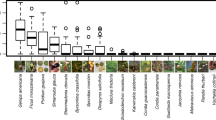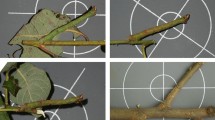Abstract
The primary function of ripe, fleshy fruit is to facilitate seed dispersal by attracting consumers1,2, yet many fruits contain unpleasant-tasting chemicals that deter consumption by vertebrates3. Here we investigate this paradox in the chilli (Capsicum) and find that capsaicin, the chemical responsible for the fruit's peppery heat4, selectively discourages vertebrate predators without deterring more effective seed dispersers.
This is a preview of subscription content, access via your institution
Access options
Subscribe to this journal
Receive 51 print issues and online access
$199.00 per year
only $3.90 per issue
Buy this article
- Purchase on Springer Link
- Instant access to full article PDF
Prices may be subject to local taxes which are calculated during checkout

Similar content being viewed by others
References
Snow, D. W. Ibis 113, 194–202 (1971).
McKey, D. in Coevolution of Animals and Plants (eds Gilbert, L. E. & Raven, P. H) 158–191 (Univ. Texas Press, Austin, 1975).
Herrera, C. M. Am. Nat. 120, 218–241 (1982).
Cordell, G. A. & Araujo, O. E. Ann. Pharmacother. 27, 330–336 (1993).
Govindarajan, V. S. & Sathyanarayana, N. M. Crit. Rev. Food Sci. Nutr. 29, 435–474 (1991).
Caterina, M. J. et al. Nature 389, 816–824 (1997).
Mason, J. R., Bean, N. J., Shah, P. S. & Clark, L. J. Chem. Ecol. 17, 2539–2551 (1991).
Norman, D. M., Mason, J. R. & Clark, L. Wils. Bull. 104, 549–551 (1992).
Jansen, D. H. Evolution 23, 1–27 (1969).
Cipollini, M. L. & Levey, D. J. Am. Nat. 150, 346–372 (1997).
Tewksbury, J. J. et al. Conserv. Biol. 13, 98–107 (1999).
Author information
Authors and Affiliations
Corresponding author
Rights and permissions
About this article
Cite this article
Tewksbury, J., Nabhan, G. Directed deterrence by capsaicin in chillies. Nature 412, 403–404 (2001). https://doi.org/10.1038/35086653
Issue Date:
DOI: https://doi.org/10.1038/35086653
This article is cited by
-
Science and philosophy of Korea traditional foods (K-food)
Journal of Ethnic Foods (2023)
-
Exploring the philosophical values of kimchi and kimjang culture
Journal of Ethnic Foods (2022)
-
Vanillin reduction in the biosynthetic pathway of capsiate, a non-pungent component of Capsicum fruits, is catalyzed by cinnamyl alcohol dehydrogenase
Scientific Reports (2022)
-
Genetic divergence in transcriptional regulators of defense metabolism: insight into plant domestication and improvement
Plant Molecular Biology (2022)
-
Prevalence of crown and root rot of hot chilli in Central Vietnam and potential of disease management with chicken manure
Journal of Plant Pathology (2022)
Comments
By submitting a comment you agree to abide by our Terms and Community Guidelines. If you find something abusive or that does not comply with our terms or guidelines please flag it as inappropriate.



